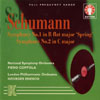Schumann Symphonies Nos 1 & 2
View record and artist detailsRecord and Artist Details
Composer or Director: Robert Schumann
Label: Dutton Laboratories
Magazine Review Date: 7/2000
Media Format: CD or Download
Media Runtime: 0
Mastering:
ADD
Catalogue Number: CDK1209

Tracks:
| Composition | Artist Credit |
|---|---|
| Symphony No. 1, 'Spring' |
Robert Schumann, Composer
National Symphony Orchestra Piero Coppola, Conductor Robert Schumann, Composer |
| Symphony No. 2 |
Robert Schumann, Composer
George Enescu, Conductor London Philharmonic Orchestra Robert Schumann, Composer |
Author: Ivan March
Two more of Mike Dutton’s miraculous transfers. I don’t seem to remember either of these recordings being among Decca’s ffrr demonstration 78s, but they have come up uncommonly well here. Indeed, one soon forgets their provenance and the age of the recordings and sits back to enjoy the music. Both interpretations come from a period when conductors unashamedly imposed their own personalities on the music-making, yet usually provided enhancement, because they were dedicated to serving the composer, rather than their own egos.
Coppola’s Spring Symphony, recorded in July 1946, opens grandly, but is essentially relaxed. He sets off with fine vigour, but there is a subtle rallentando for the entry of the second subject (mirrored nicely in the recapitulation). Other than that, the first movement presses forward vivaciously, with a splendid surge of accelerando (8'06'') and another endearing rallentando at 8'50'', full of Schumannesque warmth, then another unexaggerated spurt to the post. The Larghetto is shaped with a heartfelt yet gentle romantic impulse, and if, here, one notices that the National Symphony Strings (Sydney Beer’s famous pick-up orchestra) do not provide quite the body of tone one would expect in Berlin or Dresden, they play with much delicacy of feeling. This comes to the fore again when they are joined by the woodwind in the Trio of the Scherzo, which itself has a nice bouncing verve. The finale sets off skittishly, yet not too fast, before a Furtwanglerian pulling-back to prepare for the horn entry at 3'46'', and after the flute cadenza we gaily set off again until (around 6'20'') the momentum steadily increases for an exultant coda.
Just a year later George Enescu and the LPO took over the Kingsway Hall for the C major Symphony. Enescu’s more direct approach is evident in the first movement, appropriately vibrant for a work that needs a strong reading, but also a feeling for the light-hearted charm of the Scherzo. But the kernel of this well-remembered interpretation lies in the slow movement, opening nobly and solemnly, unerringly paced and played with restrained beauty and great concentration. There is an almost ethereal feeling of anticipation while the woodwind soliloquise, then (at 7'38'') the strings take over the cantilena with a sense of gentle unforced rapture.
The finale is vigorous without being pressed too hard, but short on molto vivace, and certainly without any visceral excitement; indeed at 4'35'' the conductor pauses momentarily, as if to take a breath, and then from 5'41'' one can feel the momentum picking up only to relax again before Ensecu gathers the threads together for his strongly enunciated coda. I have to say that not all listeners will be convinced by this finale, but overall these are fascinating performances.'
Coppola’s Spring Symphony, recorded in July 1946, opens grandly, but is essentially relaxed. He sets off with fine vigour, but there is a subtle rallentando for the entry of the second subject (mirrored nicely in the recapitulation). Other than that, the first movement presses forward vivaciously, with a splendid surge of accelerando (8'06'') and another endearing rallentando at 8'50'', full of Schumannesque warmth, then another unexaggerated spurt to the post. The Larghetto is shaped with a heartfelt yet gentle romantic impulse, and if, here, one notices that the National Symphony Strings (Sydney Beer’s famous pick-up orchestra) do not provide quite the body of tone one would expect in Berlin or Dresden, they play with much delicacy of feeling. This comes to the fore again when they are joined by the woodwind in the Trio of the Scherzo, which itself has a nice bouncing verve. The finale sets off skittishly, yet not too fast, before a Furtwanglerian pulling-back to prepare for the horn entry at 3'46'', and after the flute cadenza we gaily set off again until (around 6'20'') the momentum steadily increases for an exultant coda.
Just a year later George Enescu and the LPO took over the Kingsway Hall for the C major Symphony. Enescu’s more direct approach is evident in the first movement, appropriately vibrant for a work that needs a strong reading, but also a feeling for the light-hearted charm of the Scherzo. But the kernel of this well-remembered interpretation lies in the slow movement, opening nobly and solemnly, unerringly paced and played with restrained beauty and great concentration. There is an almost ethereal feeling of anticipation while the woodwind soliloquise, then (at 7'38'') the strings take over the cantilena with a sense of gentle unforced rapture.
The finale is vigorous without being pressed too hard, but short on molto vivace, and certainly without any visceral excitement; indeed at 4'35'' the conductor pauses momentarily, as if to take a breath, and then from 5'41'' one can feel the momentum picking up only to relax again before Ensecu gathers the threads together for his strongly enunciated coda. I have to say that not all listeners will be convinced by this finale, but overall these are fascinating performances.'
Discover the world's largest classical music catalogue with Presto Music.

Gramophone Digital Club
- Digital Edition
- Digital Archive
- Reviews Database
- Full website access
From £8.75 / month
Subscribe
Gramophone Full Club
- Print Edition
- Digital Edition
- Digital Archive
- Reviews Database
- Full website access
From £11.00 / month
Subscribe
If you are a library, university or other organisation that would be interested in an institutional subscription to Gramophone please click here for further information.




